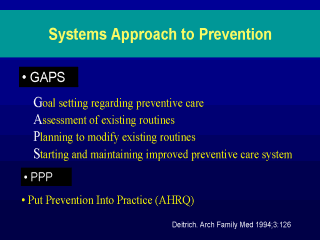 |
The agency for health care
research and quality has put out guidelines called “Put Prevention Into Practice” –
a way of incorporating prevention into primary care offices. Deitrich, who is at
Dartmouth, has done a lot of work trying to implement prevention programs in primary care
networks and has developed this GAPS approach. We’ve taken this and what we’ve really
learned from the ACES study, which was that we can’t do it just by urging people over
the phone and with letters about getting screened. It doesn’t happen. We’ve been
fortunate to get funded by the CDC to do something called a PECS study, which is
Pittsburgh Encourages Colorectal Screening. In this study, I hope we’ll be more
successful. It’s in fact (?-433) randomized design. The difference is that we are
integrating ourselves very closely, (?) the providers, and we’re going to try to
facilitate the delivery of the flex sig within the context of the provider’s
endorsement. We’re hoping that will be a more effective means of getting people
screened. |
